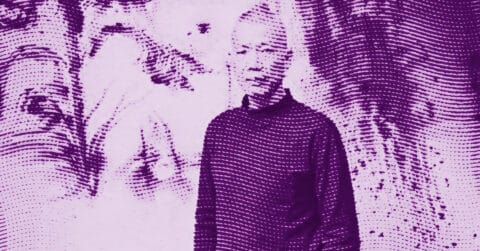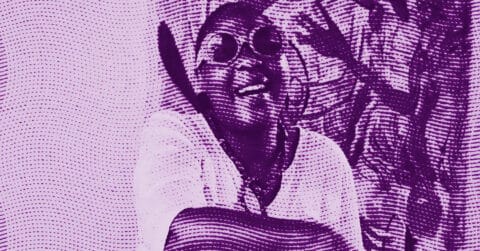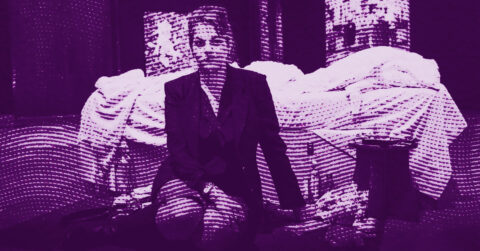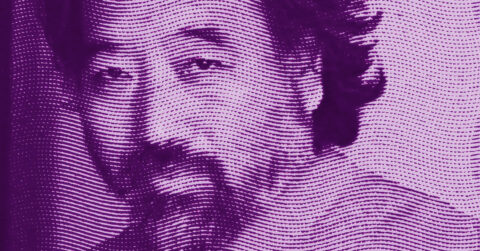Listen to me carefully, you bunch of snobs, here is a painter who sends you straight back to your own lost childhood, to those dreams of color and freedom you abandoned somewhere between your first tie and your first bank account. Hunt Slonem, this son of a naval officer born in 1951 in Maine, has been painting rabbits, birds and butterflies for fifty years with an obsession bordering on the sacred. And while you go around your conceptual installations bragging about post-modernist theories, he continues to dip his brushes into that primitive truth that eludes you: the raw beauty of nature tamed by art.
The man literally lives with his models. In his Brooklyn studio of about 3,000 square feet, around a hundred exotic birds flutter freely, creating this chromatic and sound symphony that nourishes his daily inspiration. This cohabitation is not an artist’s whim, but the tangible manifestation of a process that draws from the deepest sources of the collective unconscious. Because in Slonem, every brushstroke reveals those universal archetypes that Carl Jung identified as the psychic foundations of humanity.
Slonem’s creatures function as archetypal symbols in the Jungian sense. The bird, symbol of the soul in most religious traditions, becomes under his brush the embodiment of this spiritual quest that runs throughout his work. The rabbit, an animal of luck and fertility in popular imagination, transforms into a repetitive mandala, this geometric figure that Jung considered as the spontaneous expression of psychic wholeness. As for the butterfly, living metamorphosis, it embodies the perpetual transformation sought by the unconscious in its quest for individuation.
This repetitive approach, which the artist fully embraces by declaring that his whole life could be summed up by the word ‘exotica’, is not the fruit of creative laziness but of an intuitive understanding of deep psychic mechanisms. As Andy Warhol repeated his Campbell’s soup cans, Slonem repeats his animal motifs, but while Warhol questioned consumer society, Slonem explores the depths of the human soul. This obsessive repetition transforms the act of painting into active meditation, a visual mantra that allows access to those archaic layers of the psyche that Jung called the collective unconscious.
Henry Geldzahler, the former curator of the Metropolitan Museum, rightly noted that Slonem particularly admired Malcolm Morley, Francesco Clemente and Roberto Juarez, all “exoticists whose works convey a spiritual aura” [1]. This artistic lineage reveals the depth of a process that, beneath playful appearances, touches on the most essential questionings of human existence. The grids of hatching that cover his canvases like so many metaphorical cages are not shackles but passages, symbolic thresholds between the conscious and the unconscious, between the domestic and the wild.
The systematic use of the cross-hatching technique by Slonem actually finds its origin in a fortuitous event. Suffering from pneumonia and unable to work with oil paints, the artist turned to watercolor and began to scratch the surface of his canvases with the tip of his brush while observing his birds’ cages. This technique, born of chance and contemplation, reveals the deeply intuitive dimension of his practice. It evokes those “primordial images” that Jung described as spontaneously emerging from the unconscious, without any apparent external cause.
Slonem’s saturated colors, those acidic greens, explosive pinks, electric blues that make his compositions vibrate, contribute to this aesthetic of excess characteristic of manifestations of the collective unconscious. Jung noted that archetypes often manifest in apparent chaos, in a profusion of images and sensations that transcend rational logic. Slonem’s canvases, with their accumulation of animal figures in compressed spaces, reproduce this aesthetic of chaotic abundance characteristic of unconscious productions.
This spiritual dimension finds a remarkable echo in the artist’s other great passion: the restoration of historic homes. Slonem owns and restores several neo-Gothic style properties, including a castle of about 6,000 square meters in Massachusetts and former plantations in Louisiana. This fascination with Gothic architecture reveals a particular sensitivity to the spiritual values conveyed by this architectural style.
Gothic architecture, with its soaring vaults, flying buttresses, and rose windows, was designed to elevate the soul towards the divine. Medieval cathedrals functioned like stone books, spaces for meditation where every architectural element participated in a collective spiritual quest. Augustus Pugin, a theorist of the Gothic revival in the 19th century, affirmed that this architecture reflected a “moral and spiritual truth” that classical styles had lost.
In Slonem’s work, this Gothic sensitivity manifests in his conception of pictorial space. His compositions function as domestic sanctuaries, private chapels where the repetition of animal motifs creates the atmosphere of contemplation typical of religious buildings. The accumulation of his “rabbit walls,” installations composed of hundreds of canvases placed side by side, evokes the effect produced by Gothic stained glass windows: a sensory saturation that transports the viewer into a state of almost mystical contemplation.
This architectural dimension of his work also reveals itself in his use of old gilded frames, found at flea markets. These frames, often from the Victorian era, add a temporal dimension to his works, creating a dialogue between past and present, between artisanal tradition and contemporary creation. Like the architects of the Gothic revival who drew from the medieval heritage to nourish their modernity, Slonem uses these historical frames to anchor his contemporary visions in the long duration of art history.
The use of diamond powder on some of his canvases participates in this aesthetic of sacralization. This technique, inherited from his collaborations with Andy Warhol, transforms his animals into sparkling icons, precious relics that evoke the decorative arts of Byzantine churches or medieval illuminations enhanced with gold. This decorative dimension is not superficial but responds to a profound logic: that of the transfiguration of the everyday through art.
John Ashbery, poet and art critic, described Slonem’s works as “dazzling explosions of the changing life around us that only need to be looked at to come alive” [2]. This animation, this life that emerges from contemplation, reveals the truly spiritual dimension of this painting. It functions like those Tibetan mandalas that monks destroy after creating them, reminding us of the impermanence of all things and the necessity to cultivate a fresh perspective on the world.
Slonem’s painting resists traditional aesthetic categories. It navigates between figuration and abstraction, between assumed naivety and technical sophistication, between folk art and high art. This liminal position, this constant in-between, characterizes works that draw from the sources of the collective unconscious. Jung noted that archetypes often manifest in this indeterminate zone where opposites meet and reconcile.
The influence of Warhol on Slonem should not obscure the fundamental differences separating their respective approaches. Where Warhol mechanically reproduced images from consumer society, Slonem paints each of his canvases by hand, keeping alive this artisanal tradition that contemporary art has largely abandoned. This fidelity to the pictorial gesture, this resistance to the dematerialization of art, places his work in the lineage of great American colorists, from Milton Avery to Alex Katz.
His portraits of Abraham Lincoln, another recurring series, reveal a subtle but real political dimension. By transforming the martyred president into a pop icon, Slonem questions the mechanisms of constructing national mythologies. Lincoln becomes for him a paternal archetype, a protective figure of an idealized America where justice and compassion would reign. This series dialogues with Warhol’s Marilyns, but while the latter questioned fame and death, Slonem’s Lincolns explore collective memory and heroization.
The international dimension of Slonem’s recognition, present in more than 250 museums worldwide, attests to the universality of his message. His animals speak all languages, cross all cultural borders. They activate those deep resonances that Jung identified as traces of our common evolutionary heritage. Facing a Slonem canvas, the Western viewer experiences the same emotions as the Asian or African viewer: this immediate joy, this instinctive recognition provoked by animal beauty transfigured by art.
This universality also explains the commercial success of the artist with collectors as diverse as Sharon Stone, Julianne Moore, or members of the Kardashian family. Beyond fashion phenomena, this support reveals a deep need of our era: to regain authentic contact with nature in an increasingly artificial world. Slonem’s animals function as protective totems, symbolic guardians reminding us of our belonging to the realm of the living.
The recent evolution of his work toward sculpture and installation, notably with “Huntopia” at the San Antonio Botanical Garden, confirms this environmental dimension of his approach. These monumental works, composed of thousands of fragments of colored glass, create sanctuaries dedicated to threatened biodiversity. They function as secular cathedrals where art replaces religion in its mission to celebrate the natural sacred.
Intellectual criticism often reproaches Slonem for his apparent ease, his refusal of the conceptual complexity that characterizes dominant contemporary art. This criticism misses the point: Slonem’s art does not primarily appeal to the brain but to the senses and the soul. It reactivates those primal emotional circuits that our technological civilization has largely atrophied. In this, he aligns with Jung’s concerns, who lamented the disconnection of modern man from his collective unconscious.
The artist’s claimed spontaneity, asserting that he never knows what he will paint when entering his studio, participates in this aesthetics of immediacy that characterizes productions of the unconscious. Just as the Surrealists practiced automatic writing to bypass rational censorship, Slonem practices automatic painting that lets the creative forces of instinct express themselves.
This intuitive approach should not conceal the technical sophistication of his works. His use of color, mastery of impastos, and subtlety of compositions reveal an artist fully aware of his plastic means. This alliance between spontaneity and technical mastery characterizes great pictorial temperaments, from Van Gogh to de Kooning.
Slonem’s commitment to preserving historic architectural heritage testifies to a keen awareness of the artist’s responsibility toward collective memory. By restoring these threatened dwellings, he works to safeguard what Jung called the ‘preexisting forms’ of culture. These architectures of the past function as reservoirs of archetypes, symbolic matrices that nourish contemporary imagination.
His project to transform his properties into museums reveals a generous conception of art as a common good. At a time when contemporary art often withdraws into restricted circles of insiders, Slonem keeps alive this democratic tradition that beauty should be accessible to all. His ‘walls of rabbits’ function like popular festivals, colorful carnivals that delight the eye before moving the soul.
This festive dimension of his art should not overshadow its spiritual depth. Behind the apparent simplicity of his motifs lies a constant meditation on the mysteries of existence. His animals are as many questions posed to the meaning of life, as many invitations to rediscover that childhood part surviving in each of us despite the wounds of time.
Hunt Slonem’s art reminds us that painting, before being a discourse, is above all a sensory experience. His canvases function as happiness machines, generators of positive emotion that act directly on our nervous system. They reactivate those circuits of aesthetic pleasure that conceptual art largely neglected, recovering that cathartic function that art assumed in traditional societies.
This unique position in the contemporary art landscape makes Slonem a bridge between worlds. A bridge between popular art and learned art, between tradition and modernity, between America and Europe, between the conscious and the unconscious. His work embodies this ability of true art to reconcile opposites, to create unity in diversity.
It must be recognized that Hunt Slonem has achieved an impossible feat: remaining true to a personal vision while reaching an international audience, keeping the painting tradition alive while inventing an original visual language, celebrating natural beauty while questioning contemporary issues. His art teaches us that apparent simplicity can conceal unsuspected depths, that repetition can create meaning, that instinct can guide the hand more surely than any concept.
In a time troubled by ecological and spiritual crises, Slonem’s art offers a temporary refuge, a colorful haven where humanity can reconnect with its animal roots and its sacred dimension. His leaping rabbits, multicolored birds, and shimmering butterflies remind us that we belong to this great book of nature, of which we are but one page. By reconnecting with these universal archetypes, they invite us to rediscover the divine part that lies dormant in every living being.
- Henry Geldzahler, cited in the official biography of Hunt Slonem, website visited in June 2025
- John Ashbery, art critic, cited in the official biography of Hunt Slonem, website visited in June 2025
















